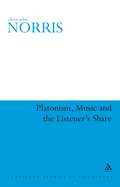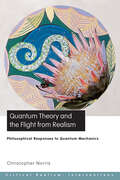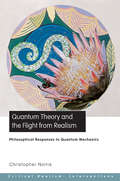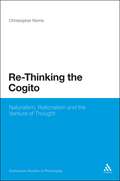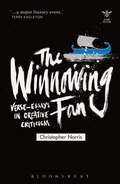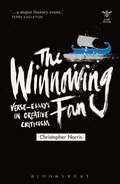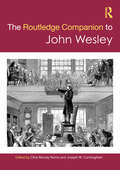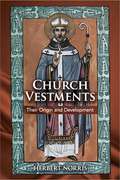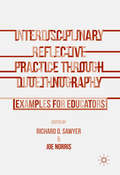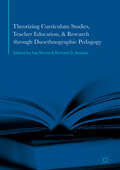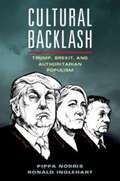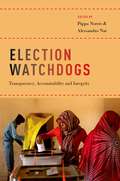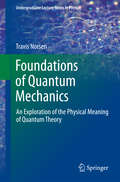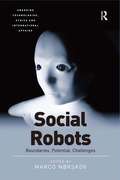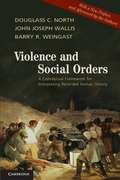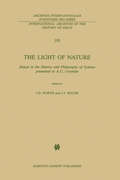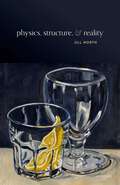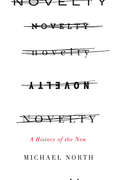- Table View
- List View
Platonism, Music and the Listener's Share (Continuum Studies in Philosophy)
by Christopher NorrisWhat is a musical work? What are its identity-conditions and the standards (if any) that they set for a competent, intelligent, and musically perceptive act of performance or audition? Should the work-concept henceforth be dissolved as some New Musicologists would have it into the various, ever-changing socio-cultural or ideological contexts that make up its reception-history to date? Can music be thought of as possessing certain attributes, structural features, or intrinsically valuable qualities that are response-transcendent, i.e., that might always elude or surpass the best state of (current or future) informed opinion? These are some of the questions that Christopher Norris addresses by way of a sustained critical engagement with the New Musicology and other debates in recent philosophy of music. His book puts the case for a qualified Platonist approach that would respect the relative autonomy of musical works as objects of more or less adequate understanding, appreciation, and evaluative judgement. At the same time this approach would leave room for listeners share the phenomenology of musical experience in so far as those works necessarily depend for their repeated realisation from one performance or audition to the next upon certain subjectively salient modalities of human perceptual and cognitive response. Norris argues for a more philosophically and musically informed treatment of these issues that combines the best insights of the analytic and the continental traditions. Perhaps the most distinctive feature of Norris's book, true to this dual orientation, is its way of raising such issues through a constant appeal to the vivid actuality of music as a challenge to philosophic thought. This is a fascinating study of musical understanding from one of the worlds leading contemporary theorists.
Quantum Theory and the Flight from Realism: Philosophical Responses to Quantum Mechanics (Critical Realism Ser.)
by Christopher NorrisThis book is a critical introduction to the long-standing debate concerning the conceptual foundations of quantum mechanics and the problems it has posed for physicists and philosophers from Einstein to the present. Quantum theory has been a major infulence on postmodernism, and presents significant problems for realists. Keeping his own realist position in check, Christopher Norris subjects a wide range of key opponents and supporters of realism to a high and equal level of scrutiny. With a characteristic combination of rigour and intellectual generosity, he draws out the merits and weaknesses from opposing arguments. In a sequence of closely argued chapters, Norris examines the premises of orthodox quantum theory, as developed most influentially by Bohr and Heisenberg, and its impact on varous philosophical developments. These include the ideas developed by W.V Quine, Thomas Kuhn, Michael Dummett, Bas van Fraassen, and Hilary Puttnam. In each case, Norris argues, these thinkers have been influenced by the orthodox construal of quantum mechanics as requiring drastic revision of principles which had hitherto defined the very nature of scientific method, causal explanati and rational enquiry. Putting the case for a realist approach which adheres to well-tried scientific principles of causal reasoning and inference to the best explanation, Christopher Norris clarifies these debates to a non-specialist readership and scholars of philosophy, science studies and the philosophy of science alike. Quantum Theory and the Flight From Realism suggests that philosophical reflection can contribute to a better understanding of these crucial, current issues.
Quantum Theory and the Flight from Realism: Philosophical Responses to Quantum Mechanics
by Christopher NorrisThis book is a critical introduction to the long-standing debate concerning the conceptual foundations of quantum mechanics and the problems it has posed for physicists and philosophers from Einstein to the present. Quantum theory has been a major infulence on postmodernism, and presents significant problems for realists. Keeping his own realist position in check, Christopher Norris subjects a wide range of key opponents and supporters of realism to a high and equal level of scrutiny. With a characteristic combination of rigour and intellectual generosity, he draws out the merits and weaknesses from opposing arguments. In a sequence of closely argued chapters, Norris examines the premises of orthodox quantum theory, as developed most influentially by Bohr and Heisenberg, and its impact on varous philosophical developments. These include the ideas developed by W.V Quine, Thomas Kuhn, Michael Dummett, Bas van Fraassen, and Hilary Puttnam. In each case, Norris argues, these thinkers have been influenced by the orthodox construal of quantum mechanics as requiring drastic revision of principles which had hitherto defined the very nature of scientific method, causal explanati and rational enquiry. Putting the case for a realist approach which adheres to well-tried scientific principles of causal reasoning and inference to the best explanation, Christopher Norris clarifies these debates to a non-specialist readership and scholars of philosophy, science studies and the philosophy of science alike. Quantum Theory and the Flight From Realism suggests that philosophical reflection can contribute to a better understanding of these crucial, current issues.
Re-Thinking the Cogito: Naturalism, Reason and the Venture of Thought (Continuum Studies in Philosophy)
by Christopher NorrisRe-Thinking the Cogito seeks to combine a strongly naturalistic with a distinctively rationalist perspective on some nowadays much-discussed issues in philosophy of mind. Against the common view that they involve downright incompatible conceptions of mind, knowledge and ethics it seeks to unite a naturalism that draws on recent advances in neurophysiology and cognitive science with an outlook that gives full weight to those normative values at the heart of rationalist thought.True to the book's constructive spirit, Norris offers various detailed proposals for bringing the two approaches into a mutually enhancing - though also mutually provocative - relationship. He finds that claim strikingly prefigured in Spinoza's working-out of a non-reductive yet metaphysically uncompromising mind/body monism. Moreover he suggests how a thoroughly naturalised approach might yet become a locus of productive engagement with the work of an ultra-rationalist thinker such as Alain Badiou. Thus Norris puts the case that physically embodied human thought has cognitive, intellectual and creative powers that cannot and need not be accounted for in terms of conscious (let alone self-conscious) reflection.
The Winnowing Fan: Verse-Essays in Creative Criticism (Beyond Criticism)
by Christopher NorrisThis path-breaking book explores different ways in which writing about poetry can deepen and extend our critical engagement by deploying creatively the manifold resources of poetic language and form. Through a series of verse-essays, reflective monologues, and inventive variations on topics in literary theory The Winnowing Fan makes a strong case for revising received ideas about the scope and limits of criticism.Norris's poems traverse the full range of European poetic history from Homer's Odyssey, through the work of French symbolists such as Mallarmé, to modern writers such as Yeats, Benjamin, Heaney, Larkin, and Barthes. There are also verse-essays and shorter pieces on philosophers from Hume and Leibniz to Heidegger, Althusser, Derrida, de Man, Rorty, Deleuze, Badiou, and Agamben. In each case Norris seeks to free criticism from conventional academic forms and return it to an active mutual engagement with the practice of literature itself.
The Winnowing Fan: Verse-Essays in Creative Criticism (Beyond Criticism)
by Christopher NorrisThis path-breaking book explores different ways in which writing about poetry can deepen and extend our critical engagement by deploying creatively the manifold resources of poetic language and form. Through a series of verse-essays, reflective monologues, and inventive variations on topics in literary theory The Winnowing Fan makes a strong case for revising received ideas about the scope and limits of criticism.Norris's poems traverse the full range of European poetic history from Homer's Odyssey, through the work of French symbolists such as Mallarmé, to modern writers such as Yeats, Benjamin, Heaney, Larkin, and Barthes. There are also verse-essays and shorter pieces on philosophers from Hume and Leibniz to Heidegger, Althusser, Derrida, de Man, Rorty, Deleuze, Badiou, and Agamben. In each case Norris seeks to free criticism from conventional academic forms and return it to an active mutual engagement with the practice of literature itself.
The Routledge Companion to John Wesley (Routledge Religion Companions)
by Clive Murray Norris Joseph W. CunninghamThe Routledge Companion to John Wesley provides an overview of the work and ideas of one of the principal founders of Methodism, John Wesley (1703-91). Wesley remains highly influential, especially within the worldwide Methodist movement of some eighty million people. As a preacher and religious reformer his efforts led to the rise of a global Protestant movement, but the wide-ranging topics addressed in his writings also suggest a mind steeped in the intellectual developments of the North Atlantic, early modern world. His numerous publications cover not only theology but ethics, history, aesthetics, politics, human rights, health and wellbeing, cosmology and ecology. This volume places Wesley within his eighteenth-century context, analyzes his contribution to thought across his multiple interests, and assesses his continuing relevance today. It contains essays by an international team of scholars, drawn from within the Methodist tradition and beyond. This is a valuable reference particularly for scholars of Methodist Studies, theology, church history and religious history.
Church Vestments: Their Origin and Development
by Herbert NorrisThe Christian church's earliest vestments were hardly distinguishable from the everyday dress of ordinary people in ancient Rome, but in time, ecclesiastical dress acquired its own distinguishing characteristics. This comprehensive reference by noted English costume authority Herbert Norris traces the evolution of clerical attire through the centuries until the end of the 1400s.The meticulously researched text is enhanced by more than 270 of the author's own illustrations, including 8 in full color, adapted from originals but specially redrawn to accentuate essential features of the garments. The vestments are treated in the approximate order of their appearance in liturgical ritual, beginning with the simple alb and including the pallium, chasuble, cassock, surplice, mitre, and many other items. Footwear, crosses, headgear, rings, gloves, and other accessories are also depicted and described in detail. Replete with fascinating historical facts and lore, this volume is an indispensable reference for students, scholars, and anyone interested in the history of ecclesiastical attire.
Interdisciplinary Reflective Practice through Duoethnography: Examples for Educators
by Joe Norris Richard SawyerThis book explores the value of duoethnography to the study of interdisciplinary practice. Through rich stories, scholars illustrate how dialogic and relational forms of research help to facilitate deeply emic, personal, and situated understandings of practice and promote personal reflexivity and changes in practice. In this book, students, teachers, and practitioners use duoethnography to become more aware, dialogic, imaginative, and relational in their teaching. Forms of practice examined in this book include education, drama, nursing, counseling, and art in classroom, university, and larger professional spaces.
Theorizing Curriculum Studies, Teacher Education, and Research through Duoethnographic Pedagogy
by Joe Norris Richard D. SawyerThis book explores the value of duoethnography to the study of interdisciplinary practice. Illustrating how dialogic and relational forms of research help to facilitate deeply emic, personal, and situated understandings of practice, the editors and contributors promote personal reflexivity and changes in practice. Education, drama, nursing counselling, and art in classroom, university, and larger professional spaces are examined by students, teachers, and practitioners using duoethnography to become more aware, dialogic, imaginative, and relational in their teaching.
Election Watchdogs: Transparency, Accountability and Integrity
by Pippa Norris Alessandro NaiRecent decades have seen growing concern regarding problems of electoral integrity. The most overt malpractices used by rulers include imprisoning dissidents, harassing adversaries, coercing voters, vote-rigging counts, and even blatant disregard for the popular vote. Elsewhere minor irregularities are common, exemplified by inaccurate voter registers, maladministration of polling facilities, lack of security in absentee ballots, pro-government media bias, ballot miscounts, and gerrymandering. Serious violations of human rights that undermine electoral credibility are widely condemned by domestic observers and the international community. Recent protests about integrity have mobilized in countries as diverse as Russia, Mexico, and Egypt. However, long-standing democracies are far from immune to these ills; past problems include the notorious hanging chads in Florida in 2000 and more recent accusations of voter fraud and voter suppression during the Obama-Romney contest. When problems come to light, however, is anyone held to account and are effective remedies implemented? In response to these developments, there have been growing attempts to analyze flaws in electoral integrity and transparency using systematic data from cross-national time-series, forensic analysis, field experiments, case studies, and new instruments monitoring mass and elite perceptions of malpractices. This volume collects essays from international experts who evaluate the robustness, conceptual validity, and reliability of the growing body of evidence. The essays compare alternative approaches and apply these methods to evaluate the quality of elections in several areas, including the United States, Sub-Saharan Africa, and Latin America. Election Watchdogs:Transparency, Accountability and Integrity presents new insights into the importance of diverse actors who promote electoral transparency, accountability, and ultimately the integrity of electoral governance.
Foundations of Quantum Mechanics: An Exploration of the Physical Meaning of Quantum Theory (Undergraduate Lecture Notes in Physics)
by Travis NorsenAuthored by an acclaimed teacher of quantum physics and philosophy, this textbook pays special attention to the aspects that many courses sweep under the carpet. Traditional courses in quantum mechanics teach students how to use the quantum formalism to make calculations. But even the best students - indeed, especially the best students - emerge rather confused about what, exactly, the theory says is going on, physically, in microscopic systems. This supplementary textbook is designed to help such students understand that they are not alone in their confusions (luminaries such as Albert Einstein, Erwin Schroedinger, and John Stewart Bell having shared them), to sharpen their understanding of the most important difficulties associated with interpreting quantum theory in a realistic manner, and to introduce them to the most promising attempts to formulate the theory in a way that is physically clear and coherent. The text is accessible to students with at least one semester of prior exposure to quantum (or "modern") physics and includes over a hundred engaging end-of-chapter "Projects" that make the book suitable for either a traditional classroom or for self-study.
Social Robots: Boundaries, Potential, Challenges (Emerging Technologies, Ethics and International Affairs)
by Marco NørskovSocial robotics is a cutting edge research area gathering researchers and stakeholders from various disciplines and organizations. The transformational potential that these machines, in the form of, for example, caregiving, entertainment or partner robots, pose to our societies and to us as individuals seems to be limited by our technical limitations and phantasy alone. This collection contributes to the field of social robotics by exploring its boundaries from a philosophically informed standpoint. It constructively outlines central potentials and challenges and thereby also provides a stable fundament for further research of empirical, qualitative or methodological nature.
Social Robots: Boundaries, Potential, Challenges (Emerging Technologies, Ethics and International Affairs)
by Marco NørskovSocial robotics is a cutting edge research area gathering researchers and stakeholders from various disciplines and organizations. The transformational potential that these machines, in the form of, for example, caregiving, entertainment or partner robots, pose to our societies and to us as individuals seems to be limited by our technical limitations and phantasy alone. This collection contributes to the field of social robotics by exploring its boundaries from a philosophically informed standpoint. It constructively outlines central potentials and challenges and thereby also provides a stable fundament for further research of empirical, qualitative or methodological nature.
Violence And Social Orders (PDF)
by Douglass C. North John Joseph Wallis Barry R. WeingastAll societies must deal with the possibility of violence, and they do so in different ways. This book integrates the problem of violence into a larger social science and historical framework, showing how economic and political behavior are closely linked. Most societies, which we call natural states, limit violence by political manipulation of the economy to create privileged interests. These privileges limit the use of violence by powerful individuals, but doing so hinders both economic and political development. In contrast, modern societies create open access to economic and political organizations, fostering political and economic competition. The book provides a framework for understanding the two types of social orders, why open access societies are both politically and economically more developed, and how some 25 countries have made the transition between the two types.
The Light of Nature: Essays in the History and Philosophy of Science presented to A.C. Crombie (International Archives of the History of Ideas Archives internationales d'histoire des idées #110)
by J. D. North J. J. RocheThis volume of essays is meant as a tribute to Alistair Crombie by some of those who have studied with him. The occasion of its publication is his seven tieth birthday - 4 November 1985. Its contents are a reflection - or so it is hoped - of his own interests, and they indicate at the same time his influence on subjects he has pursued for some forty years. Born in Brisbane, Australia, Alistair Cameron Crombie took a first degree in zoology at the University of Melbourne in 1938, after which he moved to Je sus College, Cambridge. There he took a doctorate in the same subject (with a dissertation on population dynamics - foreshadowing a later interest in the history of Darwinism) in 1942. By this time he had taken up a research position with the Ministry of Agriculture and Fisheries in the Cambridge Zoological La boratory, a position he left in 1946, when he moved to a lectureship in the his tory and philosophy of science at University College, London. H. G. Andrewa ka and L. C. Birch, in a survey of the history of insect ecology (R. F. Smith, et al. , History of Entomology, 1973), recognise the importance of the works of Crombie (with which they couple the earlier work of Gause) as the principal sti mulus for the great interest taken in interspecific competition in the mid 194Os.
Physics, Structure, and Reality
by Jill NorthIn Physics, Structure, and Reality, Jill North addresses a set of questions that get to the heart of the project of interpreting physics—of figuring out what physics is telling us about the world. How do we figure out the nature of the world from a mathematically formulated physical theory? What do we infer about the world when a physical theory can be mathematically formulated in different ways? North argues that there is a certain notion of structure, implicit in physics and mathematics, to which we should pay careful attention in order to discern what physics is telling us about the nature of reality. North draws lessons for related topics, including the use of coordinate systems in physics, the differences among various formulations of classical mechanics, the nature of spacetime structure, the equivalence of physical theories, and the importance of scientific explanation. Although the book does not explicitly defend scientific realism, instead taking this to be a background assumption, the account provides an indirect case for realism toward our best theories of physics.
Physics, Structure, and Reality
by Jill NorthIn Physics, Structure, and Reality, Jill North addresses a set of questions that get to the heart of the project of interpreting physics—of figuring out what physics is telling us about the world. How do we figure out the nature of the world from a mathematically formulated physical theory? What do we infer about the world when a physical theory can be mathematically formulated in different ways? North argues that there is a certain notion of structure, implicit in physics and mathematics, to which we should pay careful attention in order to discern what physics is telling us about the nature of reality. North draws lessons for related topics, including the use of coordinate systems in physics, the differences among various formulations of classical mechanics, the nature of spacetime structure, the equivalence of physical theories, and the importance of scientific explanation. Although the book does not explicitly defend scientific realism, instead taking this to be a background assumption, the account provides an indirect case for realism toward our best theories of physics.
Novelty: A History of the New
by Michael NorthIf art and science have one thing in common, it’s a hunger for the new—new ideas and innovations, new ways of seeing and depicting the world. But that desire for novelty carries with it a fundamental philosophical problem: If everything has to come from something, how can anything truly new emerge? Is novelty even possible? In Novelty, Michael North takes us on a dazzling tour of more than two millennia of thinking about the problem of the new, from the puzzles of the pre-Socratics all the way up to the art world of the 1960s and ’70s. The terms of the debate, North shows, were established before Plato, and have changed very little since: novelty, philosophers argued, could only arise from either recurrence or recombination. The former, found in nature’s cycles of renewal, and the latter, seen most clearly in the workings of language, between them have accounted for nearly all the ways in which novelty has been conceived in Western history, taking in reformation, renaissance, invention, revolution, and even evolution. As he pursues this idea through centuries and across disciplines, North exhibits astonishing range, drawing on figures as diverse as Charles Darwin and Robert Smithson, Thomas Kuhn and Ezra Pound, Norbert Wiener and Andy Warhol, all of whom offer different ways of grappling with the idea of originality. Novelty, North demonstrates, remains a central problem of contemporary science and literature—an ever-receding target that, in its complexity and evasiveness, continues to inspire and propel the modern. A heady, ambitious intellectual feast, Novelty is rich with insight, a masterpiece of perceptive synthesis.
Novelty: A History of the New
by Michael NorthIf art and science have one thing in common, it’s a hunger for the new—new ideas and innovations, new ways of seeing and depicting the world. But that desire for novelty carries with it a fundamental philosophical problem: If everything has to come from something, how can anything truly new emerge? Is novelty even possible? In Novelty, Michael North takes us on a dazzling tour of more than two millennia of thinking about the problem of the new, from the puzzles of the pre-Socratics all the way up to the art world of the 1960s and ’70s. The terms of the debate, North shows, were established before Plato, and have changed very little since: novelty, philosophers argued, could only arise from either recurrence or recombination. The former, found in nature’s cycles of renewal, and the latter, seen most clearly in the workings of language, between them have accounted for nearly all the ways in which novelty has been conceived in Western history, taking in reformation, renaissance, invention, revolution, and even evolution. As he pursues this idea through centuries and across disciplines, North exhibits astonishing range, drawing on figures as diverse as Charles Darwin and Robert Smithson, Thomas Kuhn and Ezra Pound, Norbert Wiener and Andy Warhol, all of whom offer different ways of grappling with the idea of originality. Novelty, North demonstrates, remains a central problem of contemporary science and literature—an ever-receding target that, in its complexity and evasiveness, continues to inspire and propel the modern. A heady, ambitious intellectual feast, Novelty is rich with insight, a masterpiece of perceptive synthesis.
Novelty: A History of the New
by Michael NorthIf art and science have one thing in common, it’s a hunger for the new—new ideas and innovations, new ways of seeing and depicting the world. But that desire for novelty carries with it a fundamental philosophical problem: If everything has to come from something, how can anything truly new emerge? Is novelty even possible? In Novelty, Michael North takes us on a dazzling tour of more than two millennia of thinking about the problem of the new, from the puzzles of the pre-Socratics all the way up to the art world of the 1960s and ’70s. The terms of the debate, North shows, were established before Plato, and have changed very little since: novelty, philosophers argued, could only arise from either recurrence or recombination. The former, found in nature’s cycles of renewal, and the latter, seen most clearly in the workings of language, between them have accounted for nearly all the ways in which novelty has been conceived in Western history, taking in reformation, renaissance, invention, revolution, and even evolution. As he pursues this idea through centuries and across disciplines, North exhibits astonishing range, drawing on figures as diverse as Charles Darwin and Robert Smithson, Thomas Kuhn and Ezra Pound, Norbert Wiener and Andy Warhol, all of whom offer different ways of grappling with the idea of originality. Novelty, North demonstrates, remains a central problem of contemporary science and literature—an ever-receding target that, in its complexity and evasiveness, continues to inspire and propel the modern. A heady, ambitious intellectual feast, Novelty is rich with insight, a masterpiece of perceptive synthesis.
Novelty: A History of the New
by Michael NorthIf art and science have one thing in common, it’s a hunger for the new—new ideas and innovations, new ways of seeing and depicting the world. But that desire for novelty carries with it a fundamental philosophical problem: If everything has to come from something, how can anything truly new emerge? Is novelty even possible? In Novelty, Michael North takes us on a dazzling tour of more than two millennia of thinking about the problem of the new, from the puzzles of the pre-Socratics all the way up to the art world of the 1960s and ’70s. The terms of the debate, North shows, were established before Plato, and have changed very little since: novelty, philosophers argued, could only arise from either recurrence or recombination. The former, found in nature’s cycles of renewal, and the latter, seen most clearly in the workings of language, between them have accounted for nearly all the ways in which novelty has been conceived in Western history, taking in reformation, renaissance, invention, revolution, and even evolution. As he pursues this idea through centuries and across disciplines, North exhibits astonishing range, drawing on figures as diverse as Charles Darwin and Robert Smithson, Thomas Kuhn and Ezra Pound, Norbert Wiener and Andy Warhol, all of whom offer different ways of grappling with the idea of originality. Novelty, North demonstrates, remains a central problem of contemporary science and literature—an ever-receding target that, in its complexity and evasiveness, continues to inspire and propel the modern. A heady, ambitious intellectual feast, Novelty is rich with insight, a masterpiece of perceptive synthesis.
Novelty: A History of the New
by Michael NorthIf art and science have one thing in common, it’s a hunger for the new—new ideas and innovations, new ways of seeing and depicting the world. But that desire for novelty carries with it a fundamental philosophical problem: If everything has to come from something, how can anything truly new emerge? Is novelty even possible? In Novelty, Michael North takes us on a dazzling tour of more than two millennia of thinking about the problem of the new, from the puzzles of the pre-Socratics all the way up to the art world of the 1960s and ’70s. The terms of the debate, North shows, were established before Plato, and have changed very little since: novelty, philosophers argued, could only arise from either recurrence or recombination. The former, found in nature’s cycles of renewal, and the latter, seen most clearly in the workings of language, between them have accounted for nearly all the ways in which novelty has been conceived in Western history, taking in reformation, renaissance, invention, revolution, and even evolution. As he pursues this idea through centuries and across disciplines, North exhibits astonishing range, drawing on figures as diverse as Charles Darwin and Robert Smithson, Thomas Kuhn and Ezra Pound, Norbert Wiener and Andy Warhol, all of whom offer different ways of grappling with the idea of originality. Novelty, North demonstrates, remains a central problem of contemporary science and literature—an ever-receding target that, in its complexity and evasiveness, continues to inspire and propel the modern. A heady, ambitious intellectual feast, Novelty is rich with insight, a masterpiece of perceptive synthesis.
Novelty: A History of the New
by Michael NorthIf art and science have one thing in common, it’s a hunger for the new—new ideas and innovations, new ways of seeing and depicting the world. But that desire for novelty carries with it a fundamental philosophical problem: If everything has to come from something, how can anything truly new emerge? Is novelty even possible? In Novelty, Michael North takes us on a dazzling tour of more than two millennia of thinking about the problem of the new, from the puzzles of the pre-Socratics all the way up to the art world of the 1960s and ’70s. The terms of the debate, North shows, were established before Plato, and have changed very little since: novelty, philosophers argued, could only arise from either recurrence or recombination. The former, found in nature’s cycles of renewal, and the latter, seen most clearly in the workings of language, between them have accounted for nearly all the ways in which novelty has been conceived in Western history, taking in reformation, renaissance, invention, revolution, and even evolution. As he pursues this idea through centuries and across disciplines, North exhibits astonishing range, drawing on figures as diverse as Charles Darwin and Robert Smithson, Thomas Kuhn and Ezra Pound, Norbert Wiener and Andy Warhol, all of whom offer different ways of grappling with the idea of originality. Novelty, North demonstrates, remains a central problem of contemporary science and literature—an ever-receding target that, in its complexity and evasiveness, continues to inspire and propel the modern. A heady, ambitious intellectual feast, Novelty is rich with insight, a masterpiece of perceptive synthesis.
